Swapping the sunshine for the cooler and calmer environment of the night offers relief, challenge and fun for all types of bike riders. Sarah Down catches some nocturnal action.
Bike riding after sundown, on the whole, is more often viewed as an unfavourable by‐product of winter’s shorter days. For those in the southern states, it probably evokes connotations of a dark commute with freezing toes despite double‐layer clothing.
As the summer heats up, however, night riding becomes less about necessity and more about a feasible, even pleasurable alternative. As soon as we conquer the primal fear of being in the dark there is much to be discovered about cycling beneath the moonlight. In northern and tropical areas, night riding is the habit of cyclists looking to beat the heat.
If you are looking to spend more time with the kids during the day, riding early mornings or late nights is a means to squeeze in exercise—or some downtime—that doesn’t compete with familial duties. After‐hours riding need not be the realm of the indoor trainer setup—the evening jaunt provides an opportunity to ride all of your favourite haunts anew, with the added benefit of sharing the road with fewer cars and avoiding the burning sun.
If the subdued urban trundle is more your style, the nightrider can be easily seduced by the reflection of the city’s lights, say against a body of water, on the journey home from an evening out. “There is a romance,” wrote Robert Louis Stevenson, “to all who are abroad in the black hours.”
Natasha Prewett signed up for Melbourne’s first Ride the Night event in 2014, keen to try out a new experience. Her fondest moment “was sitting on Port Melbourne beach at 4am, eating a cookie on the sand, watching the riders flow past.” She notes the serene circumstance may never have transpired if weren’t for signing up for the nocturnal challenge.
Ride the Night is the biggest bike riding event of its kind in Australia. Brisbane and Hobart will join Melbourne in staging the ride this year, allowing even more riders to take to the streets of their city after dark. Ride the Night also raises awareness and funds to help break the cycle of disadvantage amongst our young people.
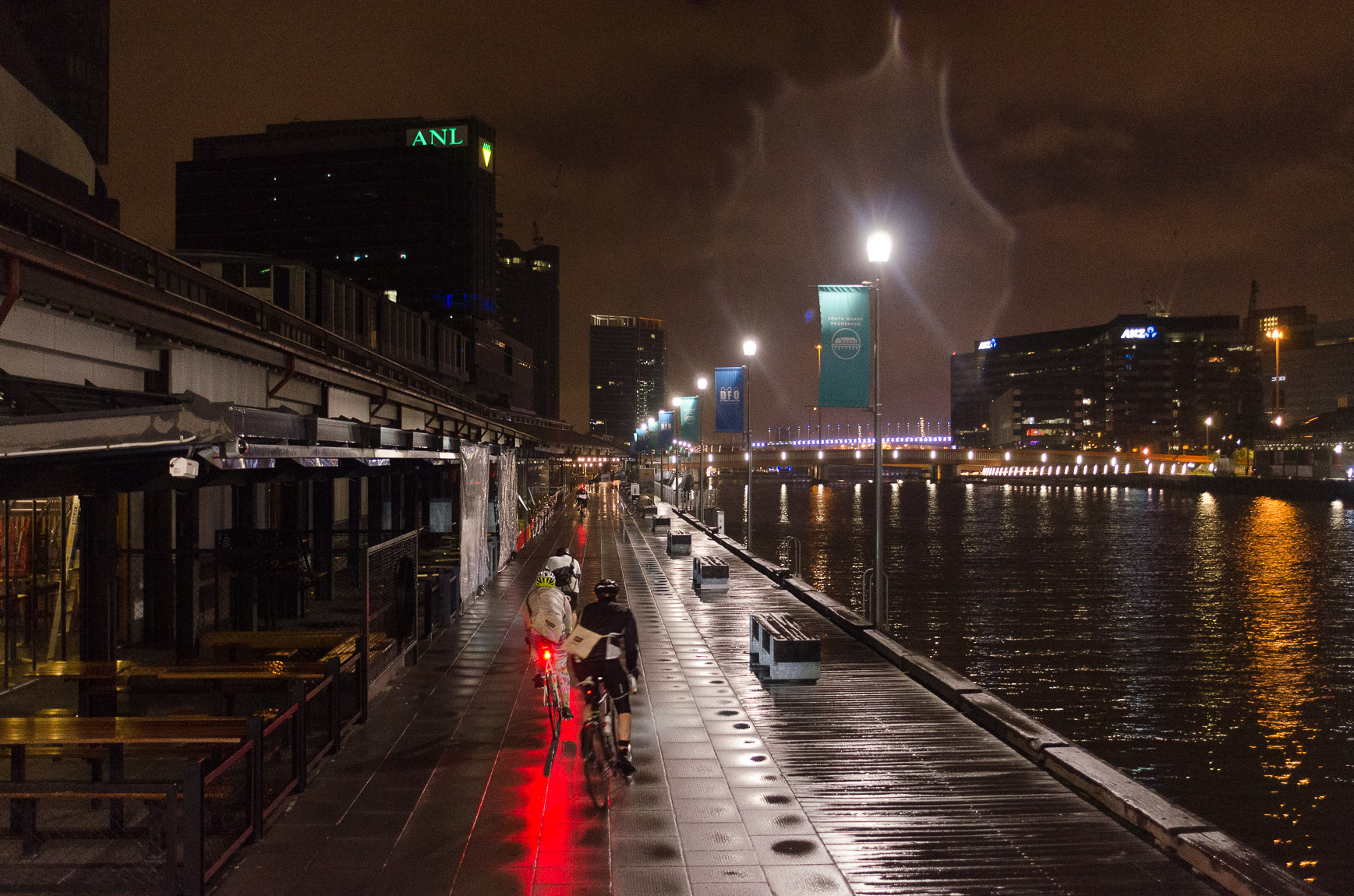
Prewett believes night cycling encourages camaraderie between riders, a sentiment she thought was cemented at Ride the Night. Next year, she’s thinking of bringing her mum along to join in the fun.
“Watching the sun rise over Albert Park Lake after a long night of riding at the Ride the Night event was also really beautiful—before I went home to bed,” she remembers.
Prewett wasn’t new to getting about after dark by bike—her wheels transport her between many activities—her favourite route being the bike path along the Yarra river heading into the city.
“I love how the coloured lights of the soccer stadium reflect on the water and I like to listen to the bats in the trees. The lights in the trees outside the National Gallery of Victoria are also a highlight of my ride.
“The air is fresher and the roads are not as busy. There’s also a lot of great buskers out and riding is a great way to experience that. It can be exhilarating when I’m heading into town, but when I’m riding home from work I’m not in a rush so I use it as a chance to relax. I find the flash of my front light quite soothing,” she says.
If soothing trundles are at one end of the spectrum, somewhere down the other end is the Audax community, whose style of riding is described as long distance. But you know that saying, ‘how long is a piece of string’? The imprecise nature of the adverb ‘long’ applies here, as what Audax call a long ride and what the average rider does are two very different things. The most iconic Audax event—not race—is the quadrennial Paris–Brest–Paris (PBP), which has its earliest finishers completing the 1,200km course in under 45 hours. Note, readers: that’s 45 continual hours on a bike including stops for power naps and nourishment—and if reports are true, the odd glass of French wine, perhaps to fuel morale?
As such, an article concerning riding at night would be less than complete if it did not include these super‐cyclists who ride day and night … then day and night. A conversation with Queensland randonneurs (long distance cyclists) Brian Hornby and Pat Lehane reveals, however, these particular folks are more distinguished enthusiasts than battle‐hardened warriors.
Between the pair, Hornby and Lehane have clocked three PBPs and an unfathomable number of kilometres—distances which amount to inhuman feats for us mere mortals. They admit that their sport tends to attract a certain person with a certain mindset. Lehane elaborates: “we don’t get much pain—it’s 98 per cent pleasure.”
To be fair, brevets (the name given to an Audax event) are not all 1,200 kilometres long—some can be as ‘short’ as two hundred. Queensland’s south‐east hosts the Esk at Night brevet, where riders depart the small township in the Darling Downs at 2pm, pedal until night offers a cool relief from the heat radiating from the road, and arrive 300 kilometres later, at sunrise, to a cooked breakfast at the finish line.
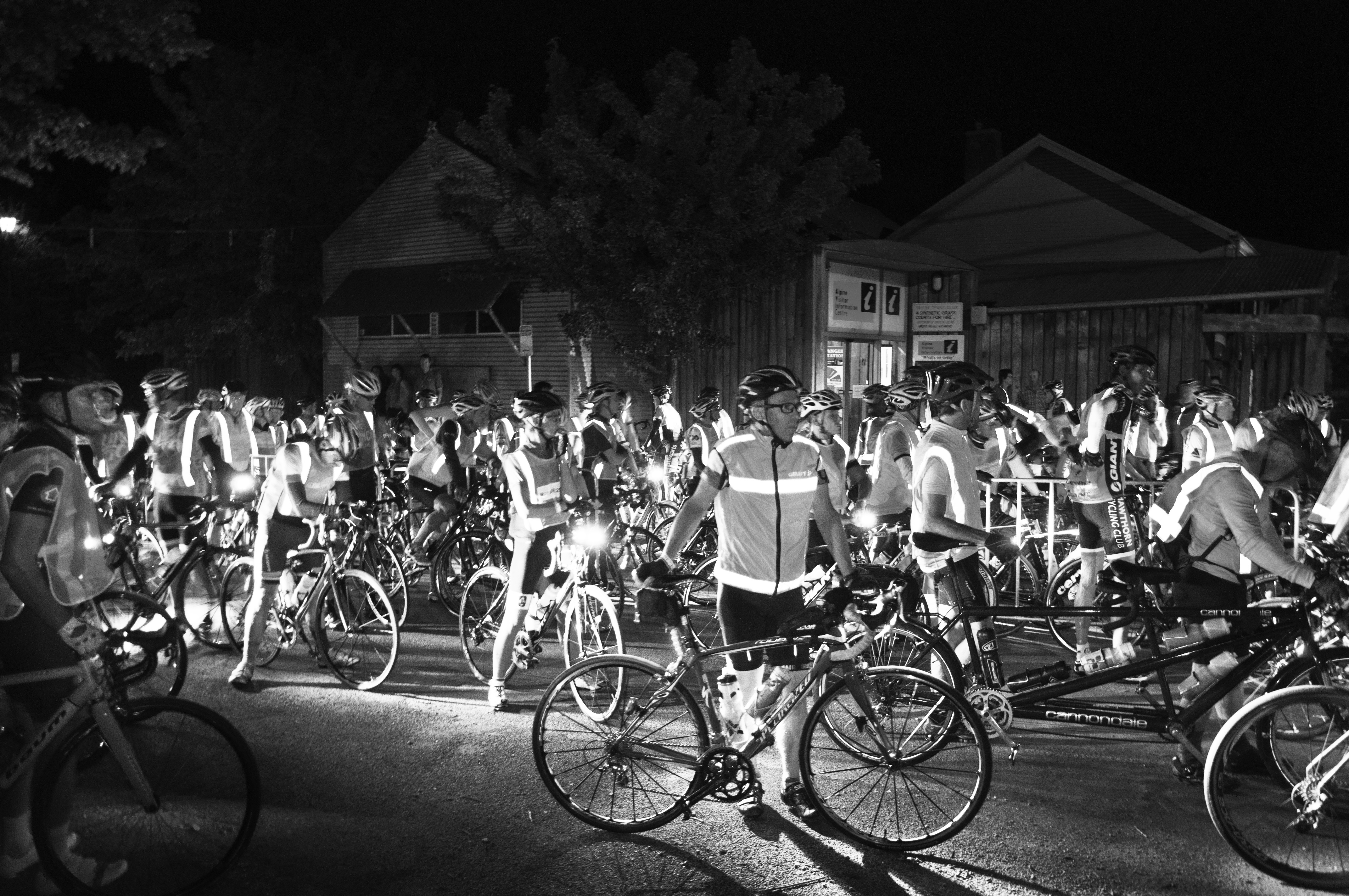
Lehane, a Toowoomba local, knows very well of the environmental considerations of riding in a Queensland summer and so he designed the event to reduce the risk of heatstroke and dehydration to participants.
“You’ll have riders who may have been flagging in the afternoon, then they’ll start to come good. It’s a result of physiological changes—the body responds to the cooler conditions of the night and no longer expends energy cooling itself down.”
Audax brevets are organised with a duty of care, with safety a major consideration, and where possible, optimised for weather conditions; however, Lehane adds that events are designed to add value to the rider’s experience. A rising sun over a lake, for example, is a gift to savour for the rider who has spent the last ten hours riding in the dark.
“We do have a tender touch to us,” laughs Lehane.
“There’s nothing nicer than the sun setting in the west and then watching the moon coming up in the east,” adds Hornby.
Indeed, dramatic vistas are not reserved to the day. Some of the longer rides are designed around the full moon, for riders to appreciate scenic moonlit panoramas.
When it comes to riding at night, enticing Hornby or Lehane to concede anything close to unfavourable, is a challenge.
Surely the lack of culinary options (on the unsupported brevets) must make for a grim evening, no? Perpetually positive, Hornby attests that a hot pie from a 24 hour servo exists as a veritable—and very delicious— saviour to the beleaguered night rider.
How about in the event of mechanical issues, which can’t be fixed by the side of the road? “If you find yourself in need of rescue and call a friend and get them up in the middle of the night … sure, they won’t be so friendly as they would be if it were the afternoon,” laughs Hornby.
When asked if riding through the night is ever a lonely venture, Lehane becomes philosophical: “If you’re fatigued it could be a long and lonely night, but sometimes the solitude is … I don’t know … it’s contemplative.”
Lehane may be onto something. According to a 2013 German study, it’s in the dark that we are at our most creative. As researchers Anna Steidle and Lioba Werth of the University of Stuttgart and the University of Hohenheim explain: “dim illumination heightens perceived freedom from constraints, which in turn improves creative performance.” So when you are stuck on a problem, or just need to clear your head, heading out for a solo night spin may bestow a burst of creativity or a relaxing reprieve.
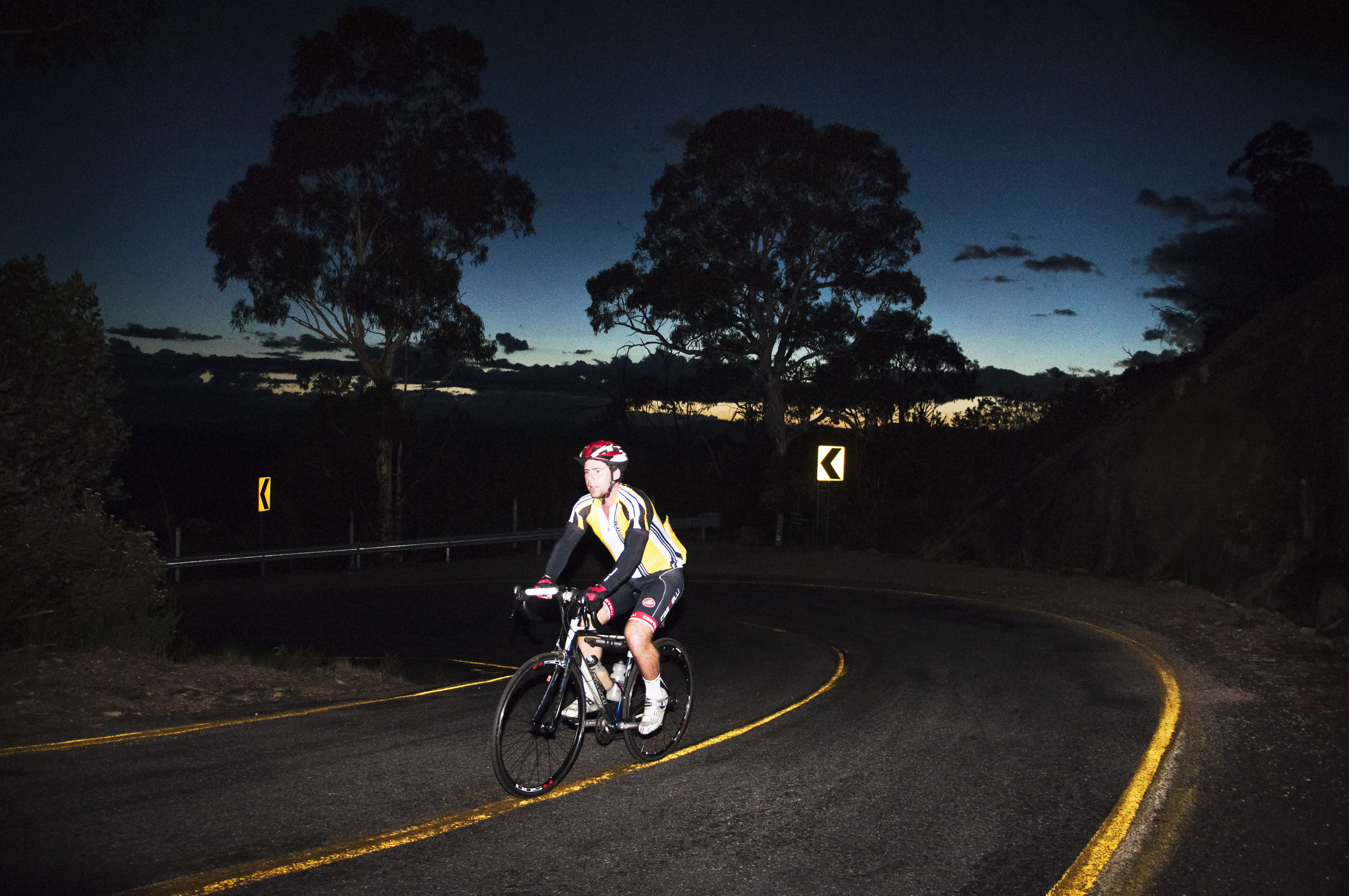
Even if, say, you’re a three time World and three time National Solo 24‐hour Mountain Biking champion. Racing a technically challenging singletrack for 24 continuous hours—which of course means through the night—may appear to be an extreme extension of a sport that’s already in the category of semi‐dangerous activities. But for Jess Douglas, night laps are her most rewarding, because it gives her “time to think”. Douglas has developed, perhaps due to the nature of her sport, a rather metaphysical approach to the notion of time, where every second is as much about appreciating being in the saddle as it is about extending a lead from her competitors.
Half of the event is spent riding in the dark, and the night is where the race can be won or lost. However, for Douglas the night represents relief from a sunburned afternoon, when her legs start to thrive and when she can feel most relaxed. If you’re wondering what goes through the mind of a 24hr soloist in the wee hours of the morning—it is a mega mix of tunes with DJ Douglas in control of the playlist.
“I have to confess that I LOVE night riding. I love it when the sun goes down and I love watching the sunset and knowing soon I will turn on my lights and enjoy some quiet time—just me and whatever my light reveals of the trail. And then comes sunrise, with the first hint of daylight and the birds tweeting good morning to a new day,” she says.
But for this world champion, riding at night is particularly engaging because she never thinks too far ahead, only as far as her light will allow her see, inviting a live‐in‐the‐moment approach that engages the mind to focus on the ‘now’. “Not tomorrow, nor the bills that need paying, nor the work you should have done, but riding for the joy of the moment,” she says.
“Mountain bike riding is one thing, but add the night with some lights and who needs meditation? Who needs a psychologist? You can work out all the problems in the world as you ride and contemplate life, just a few metres at a time,” she adds.
It’s this meditative expansion of awareness that happens when chasing a narrow tunnel of light up a sinuous singletrack in the dark. The lack of peripheral vision invites the other senses to become more responsive and riders will often express greater intuition and connection with the trail. Sounds which tend to be inaudible to the day rider become crisp and projected at night, including deep breathing and the quickened beats of the heart, which is a gentle reminder of the different space in which one exists in the bush, at dark, on a bike.
Getting off‐road after sundown isn’t the exclusive realm of elite athletes in day‐long events—it’s becoming a popular pastime for mountain bikers, due somewhat to the increasing affordability of powerful lights. It also makes seasonal sense for riders in the northern half of the country as a relief from the oppressive humidity.
Vice President of the Cairns Mountain Biking Club, Adam Gowlett, provides a very tropical insight of getting out after dark on the highest profile rainforest trail system in the world. His home track is the UCI listed Smithfield park, the location of the 2014 and 2016 Cross Country (XC) and Downhill (DH) World Cup championships.
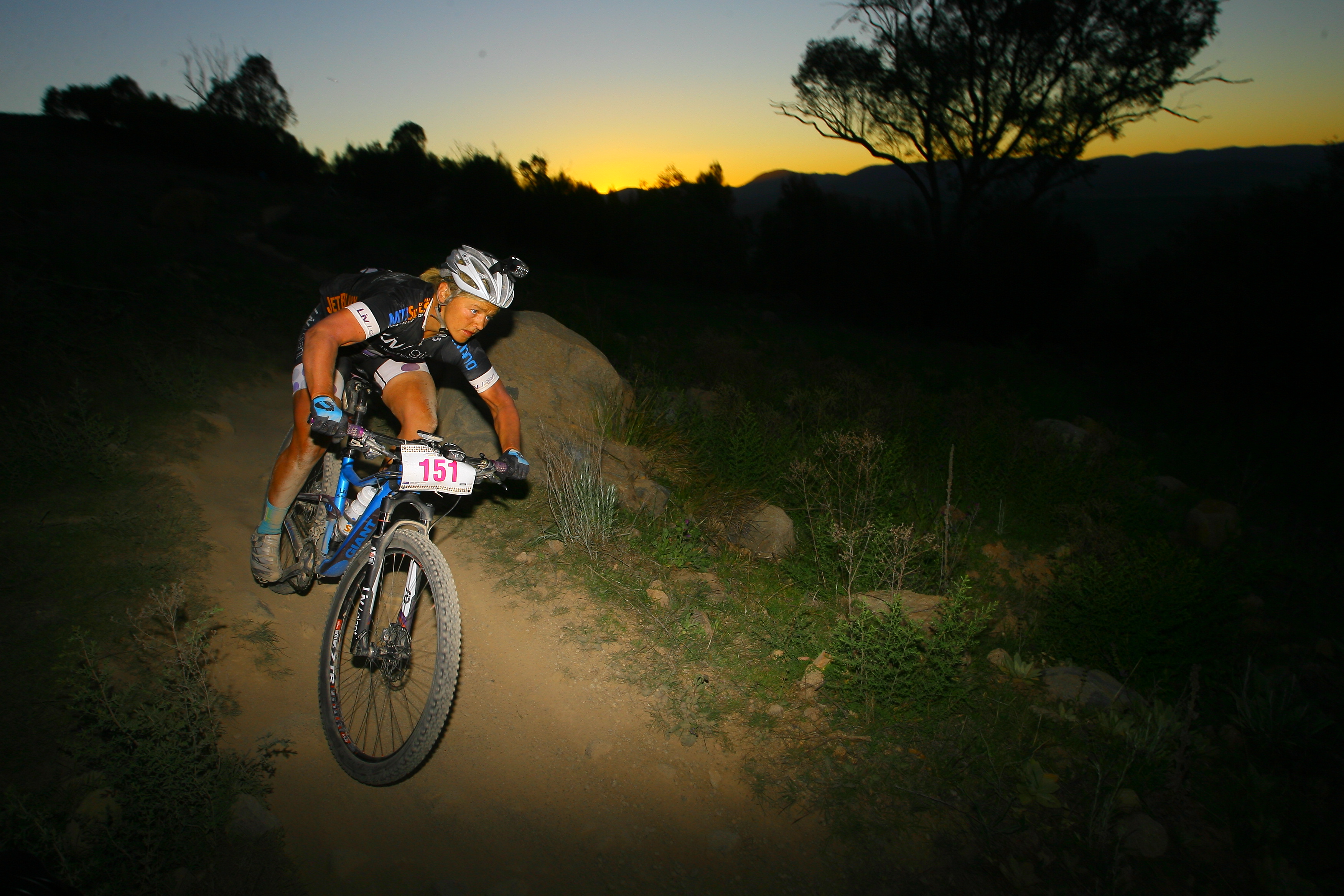
“Cairns is closer to the equator,” Gowlett explains, “so the sun drops early. By 6.30pm you get to the point you need lights to ride most of the trails. Dusk is fairly short, so by 7.00pm, it’s black—there’s no twilight inside a rainforest.”
There are a lot of riders who use Smithfield at all hours especially as the weather becomes increasingly humid. Gowlett himself prefers to squeeze in a loop during the cooler evenings, with the virtues that he needn’t be burdened lugging a hydration pack and the dark gives a whole new perspective on his trails—even those that have become boring during daylight hours, offer a whole new challenge after dusk.
“You’ve ridden the trail ten times in the last month—go and ride it at night, all of a sudden you’re riding a brand new trail. It provides a different dimension,” Gowlett explains.
The other dimension evoked from being in the dark is the peaceful connection between us and nature and Gowlett suggests the night is a “beautiful way to experience the rainforest.”
“I ride up here at night and I hear all the forest animals,” he says.
“There are bush turkeys and other rainforest birds that warble and carry on—you’ll hear pigs and other creatures rummaging in the bush. It reveals … the rainforest is alive.”
The lengthy pause invites the cautious mind to conjure up imagery of snakes and spiders of the tropically huge variety.
“Best to bunny hop, or stop,” is the advice this local gives about approaching, speedily no doubt, a three metre python which may be found draped docilely across a trail. Reassuringly, taipans are not nocturnal, so night riders are less likely to get up close and personal with one of Australia’s most venomous snakes.
As for spiders, the Golden (Giant) Orb is known to have caught an unlucky and much shaken Smithfield rider off guard. Gowlett himself, having ridden face‐first into the dinner plate sized spider at night, seems nonchalant about the interaction, advising they are placid creatures and easily extricated.
And when the full moon is high and the night is clear, Gowlett suggests that riding Smithfield approaches mountain‐biking nirvana: “Pulling up to some of the spots looking back at Cairns, with the full moon over the ocean and its reflection; being in the bush and seeing the lights of the city; listening to the animals; it’s a pretty cool place to be.”
For those enticed to ride out into the dark, take heed of the cautionary words from world champion Jessica Douglas. “Warning! Night riding does come with known side effects … addiction.”
Ride On content is editorially independent, but is supported financially by members of Bicycle Network. If you enjoy our articles and want to support the future publication of high-quality content, please consider helping out by becoming a member.

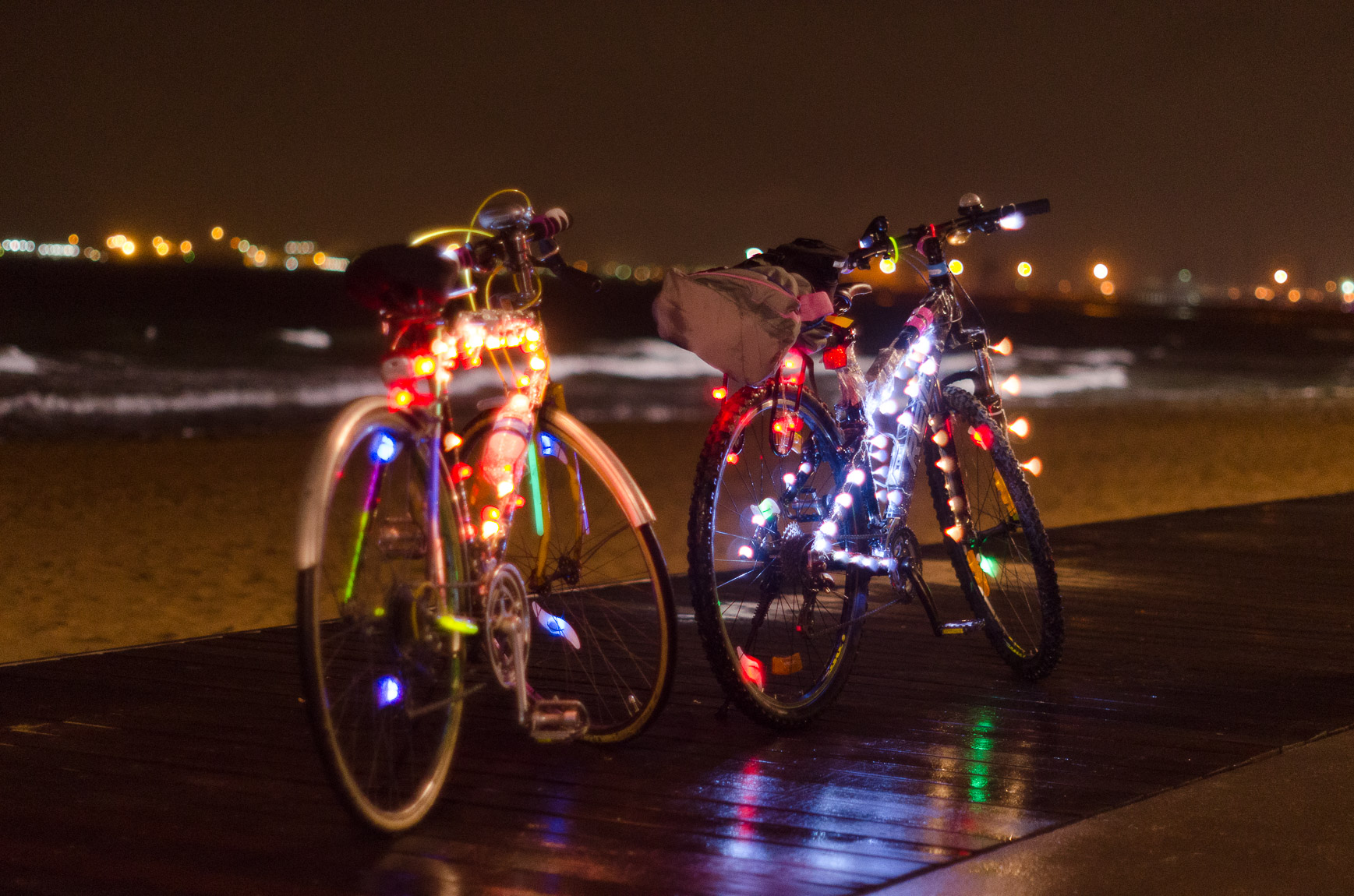
Night riding would be a great way to see kangaroos and wombats too… as long as you don’t run into them!